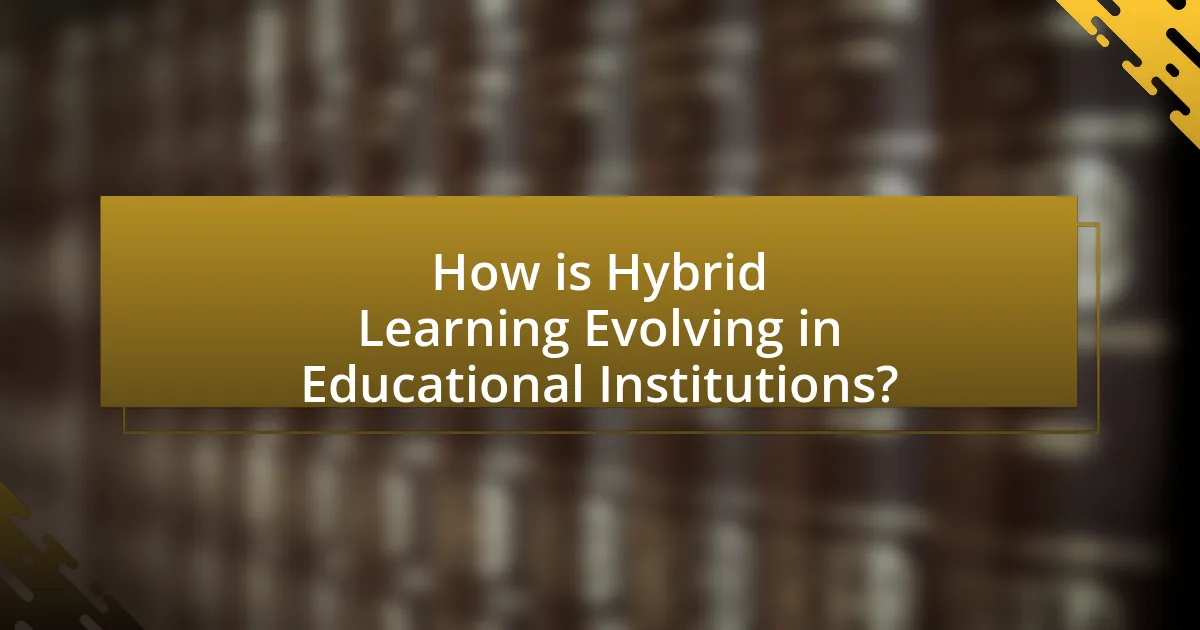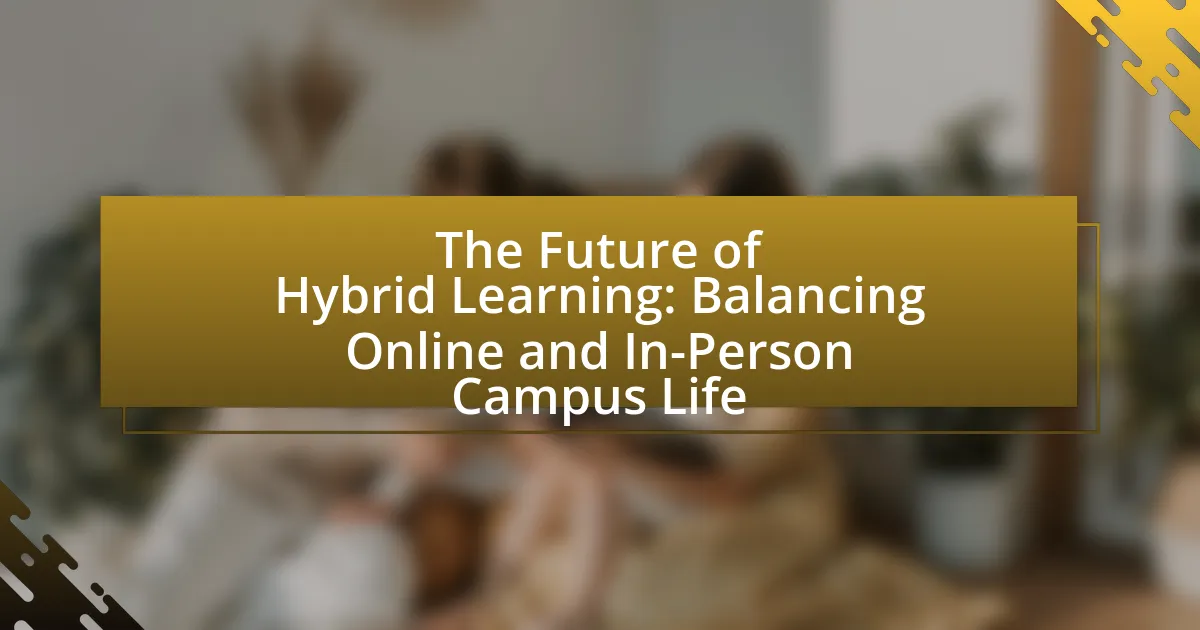Hybrid learning is an educational model that merges online digital media with traditional face-to-face classroom methods, offering flexibility and personalized learning experiences. This article explores the significance of hybrid learning for the future, highlighting its ability to enhance student engagement and improve academic outcomes. Key components of hybrid learning, such as the integration of technology and the balance between online and in-person instruction, are examined, along with the challenges it faces, including technological disparities and student engagement issues. Additionally, the article discusses best practices for fostering community and improving student outcomes in hybrid environments, emphasizing the role of faculty training and the importance of adapting curricula to meet diverse student needs.

What is Hybrid Learning and Why is it Important for the Future?
Hybrid learning is an educational approach that combines online digital media with traditional face-to-face classroom methods. This model is important for the future as it offers flexibility, accessibility, and personalized learning experiences, catering to diverse student needs. Research indicates that hybrid learning can enhance student engagement and improve learning outcomes; for instance, a study by the U.S. Department of Education found that students in blended learning environments performed better than those in purely face-to-face settings. As educational institutions adapt to technological advancements and changing student preferences, hybrid learning is poised to become a standard practice, ensuring that education remains relevant and effective in a rapidly evolving world.
How does Hybrid Learning integrate online and in-person experiences?
Hybrid learning integrates online and in-person experiences by combining digital platforms with traditional classroom settings to enhance educational accessibility and engagement. This model allows students to participate in lectures and discussions both remotely and face-to-face, facilitating a flexible learning environment. For instance, research by the Educause Review indicates that hybrid learning can improve student satisfaction and retention rates by accommodating diverse learning preferences and schedules. By leveraging technology, such as video conferencing tools and online resources, educators can create a cohesive learning experience that bridges the gap between physical and virtual classrooms.
What are the key components of Hybrid Learning?
The key components of Hybrid Learning include a blend of online and in-person instruction, flexible learning environments, and the integration of technology. This approach allows students to engage with course materials both remotely and on campus, facilitating personalized learning experiences. Research indicates that hybrid learning can enhance student engagement and improve learning outcomes by accommodating diverse learning preferences and schedules. For instance, a study by the U.S. Department of Education found that students in hybrid learning environments performed better than those in traditional settings, highlighting the effectiveness of this model.
How do these components enhance student engagement?
The components of hybrid learning enhance student engagement by providing flexibility, personalized learning experiences, and increased interaction opportunities. Flexibility allows students to choose when and where to learn, accommodating diverse schedules and learning preferences, which has been shown to improve motivation and participation. Personalized learning experiences cater to individual needs, enabling students to progress at their own pace, thereby fostering a sense of ownership over their education. Increased interaction opportunities, facilitated through online platforms and in-person activities, promote collaboration and community building, which are critical for maintaining student interest and involvement. Research indicates that students in hybrid learning environments report higher levels of engagement compared to traditional settings, as they benefit from a blend of digital resources and face-to-face interactions.
What challenges does Hybrid Learning face?
Hybrid learning faces several challenges, including technological disparities, student engagement issues, and the need for effective assessment methods. Technological disparities arise as not all students have equal access to reliable internet and devices, which can hinder participation and learning outcomes. Student engagement issues occur because the blend of online and in-person formats can lead to feelings of isolation or disengagement among learners. Additionally, effective assessment methods are required to evaluate student performance accurately in a hybrid environment, which can be complex due to the differing modalities of learning. These challenges necessitate targeted strategies to ensure equitable and effective hybrid learning experiences.
How do technological barriers impact Hybrid Learning?
Technological barriers significantly hinder Hybrid Learning by limiting access to essential digital tools and resources. Students without reliable internet connections or adequate devices face challenges in participating fully in online components of hybrid courses, leading to disparities in learning outcomes. For instance, a study by the Pew Research Center found that 15% of U.S. households with school-age children lacked high-speed internet, which directly affects their ability to engage in hybrid learning environments. Additionally, inadequate training for educators on using technology effectively can result in ineffective teaching practices, further exacerbating the learning gap.
What are the social implications of Hybrid Learning on campus life?
Hybrid learning significantly alters campus life by reshaping social interactions among students. This model creates a blend of online and in-person experiences, which can lead to reduced face-to-face engagement and a sense of isolation for some students. Research indicates that students participating in hybrid learning may struggle with building relationships, as they often miss out on spontaneous social interactions that occur in traditional classroom settings. A study published in the Journal of Educational Psychology found that students in hybrid environments reported lower levels of social connectedness compared to those in fully in-person classes. Additionally, hybrid learning can foster inclusivity for students who may have disabilities or other barriers to attending campus physically, allowing them to engage more fully in academic and social activities. However, the reliance on technology can also create a digital divide, where students without adequate access to devices or internet may feel marginalized. Overall, hybrid learning presents both challenges and opportunities for social dynamics on campus.

How is Hybrid Learning Evolving in Educational Institutions?
Hybrid learning is evolving in educational institutions by integrating advanced technology and flexible teaching methods to enhance student engagement and accessibility. Institutions are increasingly adopting blended models that combine online coursework with in-person instruction, allowing for personalized learning experiences. For instance, a study by the Educause Review in 2021 highlighted that 70% of institutions reported an increase in hybrid course offerings post-pandemic, reflecting a shift towards more adaptable educational frameworks. This evolution is driven by the need to accommodate diverse learning preferences and the growing demand for remote education options, ensuring that students can thrive in both virtual and physical environments.
What trends are shaping the future of Hybrid Learning?
The future of hybrid learning is being shaped by several key trends, including increased personalization, technological advancements, and a focus on student engagement. Personalization allows educators to tailor learning experiences to individual student needs, enhancing effectiveness; for instance, adaptive learning technologies can analyze student performance and adjust content accordingly. Technological advancements, such as virtual reality and artificial intelligence, are transforming how content is delivered and experienced, making learning more immersive and interactive. Additionally, a focus on student engagement is driving the integration of collaborative tools and platforms that facilitate interaction among students and instructors, fostering a sense of community even in a hybrid environment. These trends collectively indicate a shift towards more flexible, responsive, and engaging educational experiences in hybrid learning settings.
How are institutions adapting their curricula for Hybrid Learning?
Institutions are adapting their curricula for Hybrid Learning by integrating both online and in-person instructional methods to enhance flexibility and accessibility. This adaptation includes the development of blended courses that combine synchronous and asynchronous learning, allowing students to engage with materials at their own pace while still participating in live discussions. Additionally, institutions are investing in technology and training for faculty to effectively deliver content across multiple platforms, ensuring that learning outcomes are met regardless of the mode of delivery. For instance, a study by the Educause Review in 2021 highlighted that 70% of institutions reported increasing their use of digital tools to support hybrid models, demonstrating a significant shift towards a more integrated approach to education.
What role does faculty training play in successful Hybrid Learning?
Faculty training is essential for successful hybrid learning as it equips educators with the necessary skills and strategies to effectively integrate online and in-person teaching methods. Trained faculty can utilize technology to enhance student engagement, adapt instructional materials for diverse learning environments, and implement assessment techniques that cater to both online and face-to-face learners. Research indicates that institutions with comprehensive faculty training programs report higher student satisfaction and improved learning outcomes, demonstrating the direct impact of well-prepared educators on the effectiveness of hybrid learning models.
How does Hybrid Learning affect student outcomes?
Hybrid learning positively affects student outcomes by enhancing engagement and improving academic performance. Research indicates that students in hybrid learning environments often demonstrate higher retention rates and better understanding of material compared to traditional learning settings. A study by the U.S. Department of Education found that students in blended learning programs performed better, with a 20% increase in test scores, highlighting the effectiveness of combining online and in-person instruction. This approach allows for personalized learning experiences, catering to diverse learning styles and needs, which further contributes to improved student outcomes.
What evidence supports the effectiveness of Hybrid Learning?
Hybrid learning is supported by evidence indicating improved student engagement and academic performance. A study conducted by the U.S. Department of Education found that students in hybrid learning environments performed better, with a 20% increase in test scores compared to traditional classroom settings. Additionally, research published in the Journal of Educational Psychology demonstrated that hybrid learning fosters greater student autonomy and motivation, leading to enhanced learning outcomes. These findings collectively affirm the effectiveness of hybrid learning in educational contexts.
How do student preferences influence Hybrid Learning models?
Student preferences significantly influence Hybrid Learning models by shaping the design and implementation of these educational frameworks. When students express a preference for flexibility, institutions often adapt by offering more online components, allowing learners to engage with materials at their own pace. Research indicates that 70% of students prefer a blend of online and in-person classes, as found in a study by the Educause Review, which highlights the demand for personalized learning experiences. Additionally, student feedback on course delivery methods can lead to adjustments in curriculum structure, ensuring that learning environments cater to diverse learning styles and needs. This responsiveness to student preferences ultimately enhances engagement and satisfaction, making Hybrid Learning models more effective.

What Best Practices Can Enhance Hybrid Learning Experiences?
Best practices that can enhance hybrid learning experiences include integrating technology effectively, fostering engagement through interactive content, and providing clear communication channels. Effective technology integration, such as using learning management systems and collaborative tools, allows seamless access to resources and facilitates interaction between online and in-person students. Engaging content, like multimedia presentations and interactive discussions, promotes active participation, which has been shown to improve retention rates by up to 60% (National Training Laboratories). Clear communication channels, including regular updates and feedback mechanisms, ensure that all students feel connected and supported, which is crucial for maintaining motivation and a sense of community in hybrid environments.
How can institutions create a balanced Hybrid Learning environment?
Institutions can create a balanced Hybrid Learning environment by integrating synchronous and asynchronous learning methods effectively. This approach allows students to engage with course materials at their own pace while also participating in real-time discussions and activities. Research indicates that a well-structured hybrid model can enhance student engagement and learning outcomes; for instance, a study by the Educause Review found that hybrid courses can lead to improved retention rates and higher student satisfaction compared to traditional formats. By providing a mix of online resources, interactive tools, and in-person support, institutions can cater to diverse learning preferences and foster a more inclusive educational experience.
What strategies can be implemented to foster community in Hybrid Learning?
To foster community in Hybrid Learning, institutions can implement strategies such as creating structured online discussion forums, organizing regular virtual and in-person social events, and facilitating collaborative projects among students. Structured online discussion forums encourage interaction and engagement, allowing students to share ideas and support each other, which is essential for building a sense of belonging. Regular social events, both virtual and in-person, help students connect on a personal level, enhancing relationships and community ties. Collaborative projects promote teamwork and communication, essential components of community building, as they require students to work together towards common goals. These strategies are supported by research indicating that social interaction and collaboration significantly enhance student engagement and satisfaction in hybrid learning environments.
How can technology be leveraged to improve Hybrid Learning?
Technology can be leveraged to improve Hybrid Learning by integrating advanced digital tools that facilitate seamless interaction between online and in-person participants. For instance, platforms like Zoom and Microsoft Teams enable real-time communication, allowing students to engage in discussions regardless of their physical location. Additionally, Learning Management Systems (LMS) such as Canvas and Moodle provide centralized access to course materials, assignments, and assessments, ensuring that all students have equal opportunities to participate and succeed. Research indicates that hybrid learning environments that utilize technology effectively can enhance student engagement and academic performance, as evidenced by a study from the Journal of Educational Technology & Society, which found that students in hybrid courses reported higher satisfaction and learning outcomes compared to traditional formats.
What are the key takeaways for students and educators in Hybrid Learning?
Key takeaways for students and educators in hybrid learning include the importance of flexibility, engagement, and technology integration. Students benefit from the ability to choose between online and in-person classes, allowing for personalized learning experiences that cater to individual needs. Educators must adapt their teaching strategies to maintain student engagement across both formats, utilizing interactive tools and resources to enhance learning outcomes. Research indicates that hybrid learning can improve student performance when effectively implemented, as seen in studies showing increased retention rates and satisfaction levels among students who participate in blended environments.
What tips can help students thrive in a Hybrid Learning setting?
To thrive in a Hybrid Learning setting, students should establish a structured routine that includes dedicated study times and breaks. Research indicates that consistent schedules enhance focus and retention, as highlighted in a study by the American Psychological Association, which found that routine can significantly improve academic performance. Additionally, students should actively engage in both online and in-person components by participating in discussions and collaborating with peers, as this fosters a sense of community and enhances learning outcomes. Utilizing digital tools effectively, such as learning management systems and communication platforms, can also streamline access to resources and facilitate better organization of coursework.
How can educators effectively support students in Hybrid Learning environments?
Educators can effectively support students in hybrid learning environments by implementing structured communication, personalized learning experiences, and providing access to resources. Structured communication, such as regular check-ins and clear guidelines, fosters engagement and accountability among students. Personalized learning experiences, tailored to individual needs, enhance motivation and comprehension, as evidenced by research from the Bill & Melinda Gates Foundation, which found that personalized learning can significantly improve student outcomes. Additionally, providing access to resources, including digital tools and support services, ensures that all students can participate fully, as highlighted in a study by the U.S. Department of Education, which emphasizes the importance of equitable access to technology in hybrid settings.

Leave a Reply